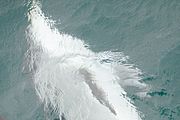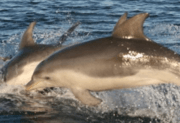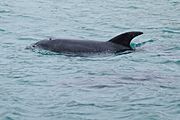Burrunan dolphin facts for kids
Quick facts for kids Burrunan dolphin |
|
|---|---|
 |
|
| A Burrunan dolphin jumping out of water | |
| Scientific classification | |
| Genus: |
Tursiops
|
| Species: |
australis
|
The Burrunan dolphin (Tursiops australis) is a special type of bottlenose dolphin. You can find it in certain parts of Victoria, Australia. Scientists officially recognized it as its own species in 2011.
Even though some people still debate it, there's a lot of evidence now. This evidence shows that the Burrunan dolphin is truly different from the common and Indo-Pacific bottlenose dolphins. There are only two main groups of these dolphins living in Victoria, Australia. Their total population is thought to be less than 180 dolphins.
Before it got its official name, scientists called it the "southern Australian bottlenose dolphin."
Contents
What's in a Name? (Taxonomy)
Scientists gave the Burrunan dolphin its formal name, Tursiops australis. This name was chosen by researcher Kate Charlton-Robb and her team from Monash University.
The common name, Burrunan, comes from the Aboriginal languages of the Boonwurrung, Woiwurrung, and Taungurung peoples. It means "large sea fish of the porpoise kind." The second part of its scientific name, australis, is a Latin word meaning "southern." This refers to where the dolphin lives in Australia.
The Burrunan dolphin is one of three known types of Tursiops (bottlenose dolphins). For a long time, scientists thought it was just another bottlenose dolphin. But they noticed some small differences. Later, they looked closely at their skulls, how they looked on the outside, and their DNA. These studies showed that the Burrunan dolphin had unique features. This led to it being classified as a separate species. It was only the third time since the late 1800s that a new dolphin species was recognized!
In 2020, some scientists questioned if it was truly a separate species. However, more recent and detailed studies using DNA and other methods have provided even stronger proof. These studies confirm that the Burrunan dolphin is indeed its own unique species.
How to Spot One (Description)
The Burrunan dolphin has a dark bluish-gray color on its back. This color goes over its head and down its sides. Along its middle, it's a lighter gray. This lighter color sometimes forms a streak near its dorsal fin (the fin on its back). Its belly is off-white. This white color can sometimes reach up over its eye and flipper.
In terms of size, the Burrunan dolphin is smaller than the common bottlenose dolphin. But it's larger than the Indo-Pacific bottlenose dolphin. It usually measures between 2.27 and 2.78 m (7.4 and 9.1 ft) long.
Where They Live (Distribution and Habitat)
The Burrunan dolphin is special because it lives only in a small area of southern and south-eastern Australia. Scientists have found only two main groups of these dolphins. One group lives in Port Phillip Bay, and the other lives in the Gippsland Lakes.
There are about 100 dolphins in Port Phillip and around 50 in Gippsland. Some Burrunan dolphins have also been seen near eastern Tasmania and in coastal waters of South Australia. Because there are so few of them, scientists think this species should be protected.
The Burrunan dolphin is listed as 'Endangered' in Victoria under the Flora and Fauna Guarantee Act 1988. This means it's at high risk of disappearing in that state. However, it's not yet listed as endangered on a national or international level because more data is needed.
Dangers They Face (Threats)
Burrunan dolphins live in bays and sheltered waters along Australia's southern coast. These areas are often busy with human activities, which can be dangerous for them.
Here are some of the threats they face:
- Human Activities: Things like dolphin-watching tours and recreational boats can bother the dolphins. This can stop them from finding food or resting.
- Small Populations: Because there are so few Burrunan dolphins, they are more at risk. A small group can be wiped out more easily by problems like disease or pollution.
- Pollution and Contaminants: Dolphins can be harmed by pollution in the water. High levels of things like mercury have been found in them.
- Diseases: They can also get sick. For example, a skin disease called Fresh water skin disease (FWSD) has affected dolphins in the Gippsland Lakes. This happens when too much fresh water flows into the lakes, which are usually salty. If these weather events happen more often, it could harm the small population there.
A study by the Marine Mammal Foundation found that boats often get too close to dolphins. This can change how dolphins behave. For example, they might spend more time mating or splashing their tails. These changes can be a sign of stress or that their communication is being interrupted.
Gallery
See also
 In Spanish: Delfín Burrunan para niños
In Spanish: Delfín Burrunan para niños





